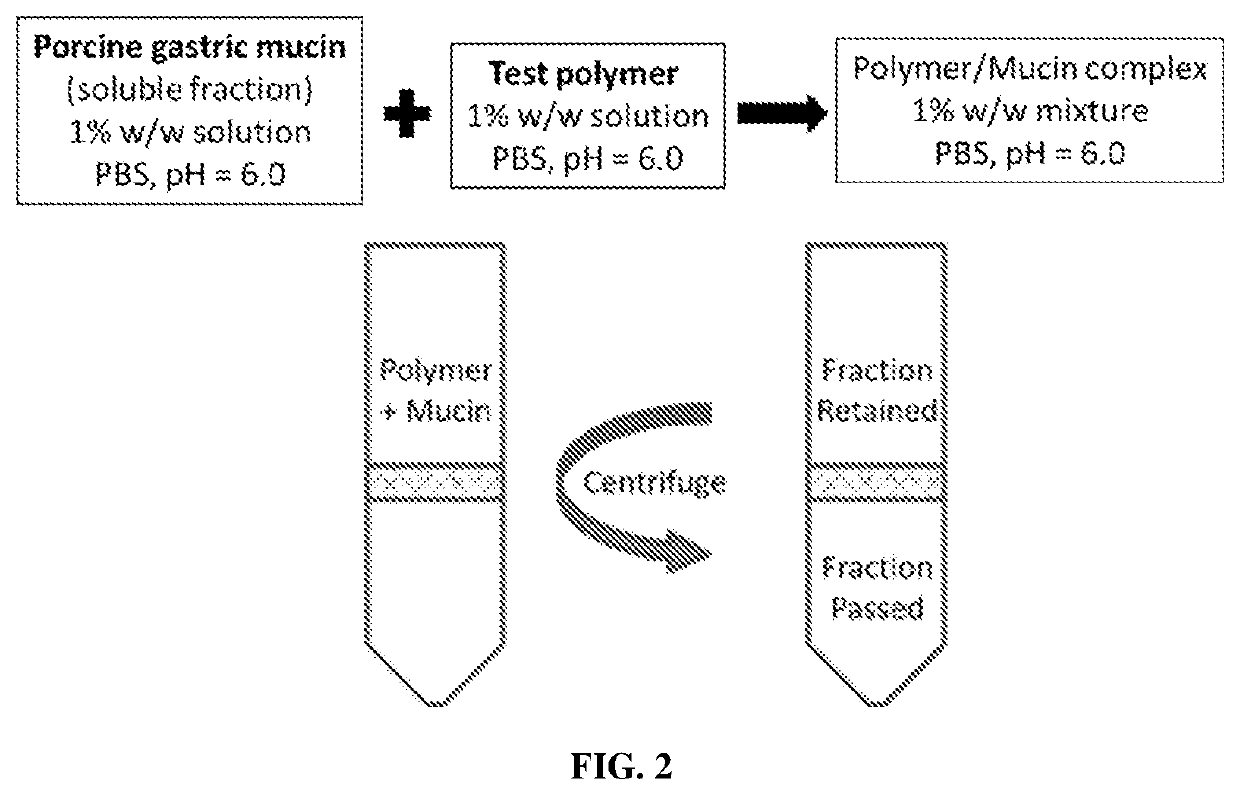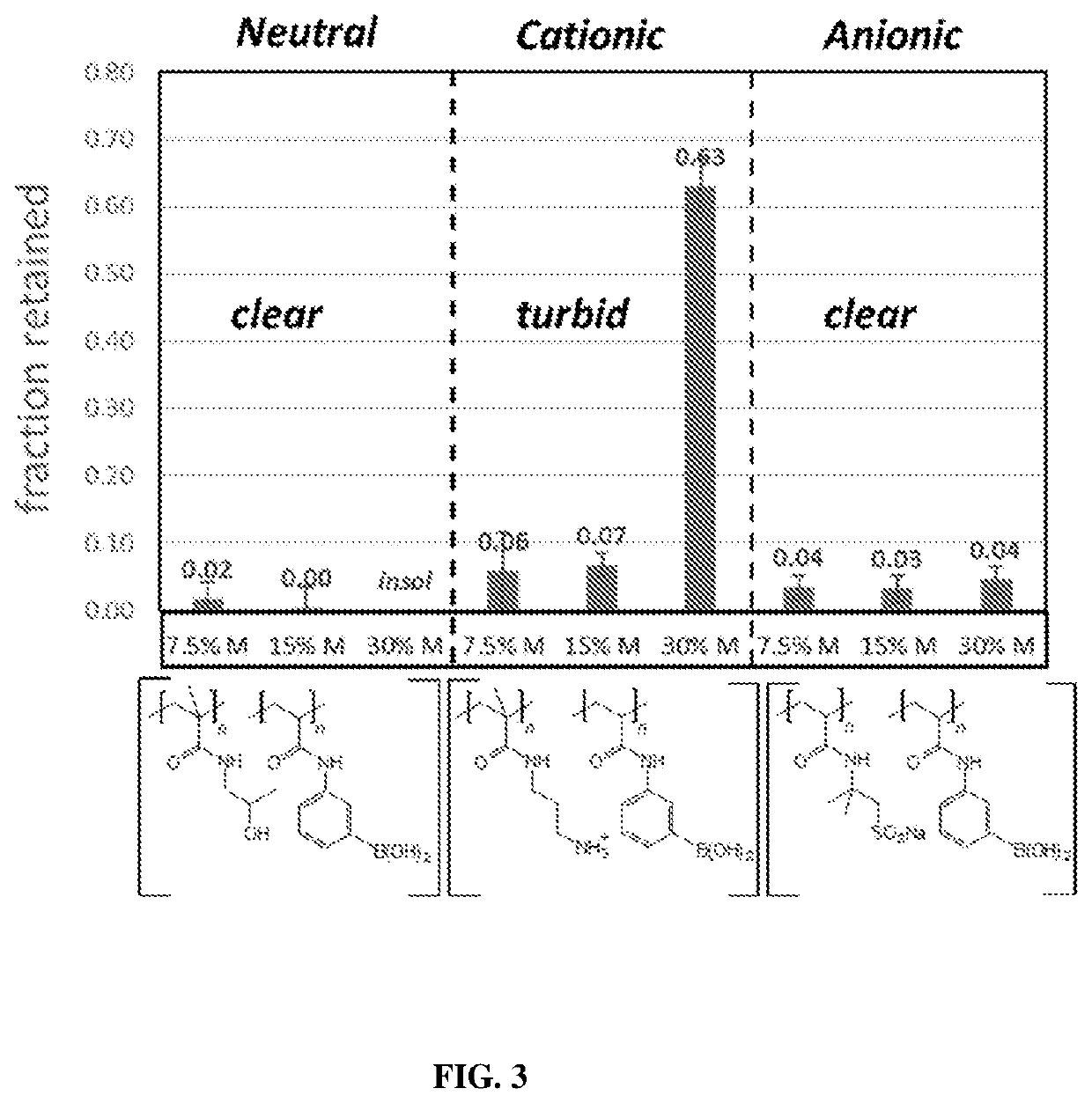Boronic acid polymers and methods of use
a technology of boronic acid and polymer, applied in the field of boronic acid polymers and methods of use, can solve the problems of inability to achieve widespread adoption of surgery and pharmacological solutions, and the gap between mucin and mucus complexing activity is large, and achieves dramatically different properties, improved mucin and mucus complexing activity, and effective condense mucin and mucus.
- Summary
- Abstract
- Description
- Claims
- Application Information
AI Technical Summary
Benefits of technology
Problems solved by technology
Method used
Image
Examples
example 1
of Poly(Allylamine Hydrochloride) / PAAn-HCl
[0132]26.28 ml of allylamine was placed into a 250 ml, 2 neck round bottom flask place equipped with magnetic stirring and N2(g) inlet. The temperature was brought to 2(g). 11.0 ml of deionized water was added to make a 50 wt % solution of allylamine hydrochloride. A nominal amount of 37 wt % HCl was added to bring the solution pH down to 2.60. 328 mg (1 wt %) of V50 initiator was then added as a solid. The monomer solution was N2(g) purged for ˜30 minutes. The reaction was then heated at 60° C. for 24 hr while under a blanket of N2(g). The viscous reaction mixture was placed into MWCO: 6 k to 8 k cellulose dialysis membrane and dialyzed over 2 to 3 days with several water changes. The dialyzed solution was passed through 1 μm filter, IPA / dry ice frozen and lyophilized. A yield of 12.79 g was obtained as a white solid.
example 2
of PAAn-4CPBA Amide (High Degree of Substitution)
[0133]2.05 g of poly(allylamine hydrochloride) and 200 ml of deionized water was placed into a 500 ml single neck round bottom flask equipped with magnetic stirring. 100 ml of ethanol was added. A slurry with 2.83 g of 4-carboxyphenylboronic acid (4-CPBA) and 50 ml of deionized water and a solution with 3.27 g of EDC-HCl and 50 ml of ethanol, denatured were made separately. The 4CPBA and EDC solutions were mixed together until mostly dissolved, ˜5 min. The “4CPBA-EDC” solution was added to the polymer solution over ˜5 min. The reaction was maintained at pH 5 with small amounts of saturated bicarbonate solution until stabilized, ˜30 min to 2 hr depending on scale. The reaction was proceeded for 18 hr while stabilized at pH 5. The contents of the reaction were precipitated from excess acetone, two times, followed by MWCO: 3.5 k cellulose membrane dialysis over 2 to 3 days with several water changes. The dialyzed solution was passed thro...
example 3
of PAAn-4CPBA Amide (Low Degree of Substitution)
[0134]2.08 g of poly(allylamine hydrochloride) and 250 ml of deionized water was placed into a 500 ml single neck round bottom flask equipped with magnetic stirring. 50 ml of ethanol was added. A slurry with 1.41 g of 4-carboxyphenylboronic acid (4-CPBA) and 50 ml of ethanol, denatured and a solution with 1.59 g of EDC-HCl and 50 ml of ethanol, denatured were made separately. The 4CPBA and EDC solutions were mixed together until mostly dissolved, ˜5 min. The “4CPBA-EDC” solution was added to the polymer solution over ˜5 min. The reaction was maintained at pH 5 with small amounts of saturated bicarbonate solution until stabilized, ˜30 min to 2 hr depending on scale. The reaction was proceeded for 18 hr while stabilized at pH 5. The contents of the reaction were precipitated from excess acetone, two times, followed by MWCO: 3.5 k cellulose membrane dialysis over 2 to 3 days with several water changes. The dialyzed solution was passed thr...
PUM
| Property | Measurement | Unit |
|---|---|---|
| pKa | aaaaa | aaaaa |
| pKa | aaaaa | aaaaa |
| pKa | aaaaa | aaaaa |
Abstract
Description
Claims
Application Information
 Login to View More
Login to View More - R&D
- Intellectual Property
- Life Sciences
- Materials
- Tech Scout
- Unparalleled Data Quality
- Higher Quality Content
- 60% Fewer Hallucinations
Browse by: Latest US Patents, China's latest patents, Technical Efficacy Thesaurus, Application Domain, Technology Topic, Popular Technical Reports.
© 2025 PatSnap. All rights reserved.Legal|Privacy policy|Modern Slavery Act Transparency Statement|Sitemap|About US| Contact US: help@patsnap.com



